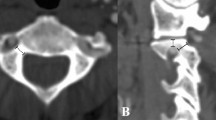Abstract
Purpose
To explore the feasibility and effectiveness of C1 pedicle screw fixation in patients whose atlas vertebral artery groove (defined as the C1 pedicle) height is less than 4 mm, but with a medullary canal.
Methods
From January 2010 to January 2013, 7 patients (6 males, 1 female) with atlantoaxial instability whose C1 pedicle height was less than 4.0 mm on one or both sides were treated by C1 pedicle screw fixation at our institution. Thirteen of the 14 C1 pedicles were less than 4.0 mm in height, but all had a medullary canal. Patients were followed up at regular intervals. Postoperative computed tomography (CT) scans were performed to assess if C1 pedicle screw placement was successful. Clinical outcomes were evaluated according to postoperative complications, the American Spinal Injury Association grading system, and bone graft status.
Results
Thirteen C1 pedicles with a height less than 4.0 mm were inserted by 13 3.5- or 4.0-mm-diameter pedicle screws, and one C1 pedicle whose height was 4.1 mm was inserted by a 4.0-mm-diameter pedicle screw. In addition, 14 pedicle screws were inserted in the axis. The mean follow-up period was 23 (range 8–38) months. No neurologic or vascular complications occurred in any of the seven patients. Postoperative CT three-dimensional reconstruction images showed that all 14 pedicle screws were inserted in the C1 pedicles without destruction of the atlas pedicle cortical bone. All patients demonstrated bony fusion 6 months postoperatively.
Conclusion
If there is a medullary canal in the C1 pedicle, a 3.5- or 4.0-mm-diameter pedicle screw can be safely inserted into the atlas and C1 pedicle screw fixation can be performed without any impact on fixation stability and clinical efficacy, even if the C1 pedicle height is less than 4.0 mm.



Similar content being viewed by others
References
Elliott RE, Tanweer O, Smith ML, Frempong-Boadu A (2013) Impact of starting point and bicortical purchase of C1 lateral mass screws on atlantoaxial fusion: meta-analysis and review of the literature. J Spinal Disord Tech. doi:10.1097/BSD.0b013e31828ffc97
Ma XY, Yin QS, Wu ZH, Xia H, Liu JF, Xiang M, Zhao WD, Zhong SZ (2009) C1 pedicle screws versus C1 lateral mass screws: comparisons of pullout strengths and biomechanical stabilities. Spine (Phila Pa 1976) 34:371–377. doi:10.1097/BRS.0b013e318193a21b
Tan M, Wang H, Wang Y, Zhang G, Yi P, Li Z, Wei H, Yang F (2003) Morphometric evaluation of screw fixation in atlas via posterior arch and lateral mass. Spine (Phila Pa 1976) 28:888–895. doi:10.1097/01.BRS.0000058719.48596.CC
Yeom JS, Kafle D, Nguyen NQ, Noh W, Park KW, Chang BS, Lee CK, Riew KD (2012) Routine insertion of the lateral mass screw via the posterior arch for C1 fixation: feasibility and related complications. Spine J 12:476–483. doi:10.1016/j.spinee.2012.06.010
Resnick DK, Benzel EC (2002) C1–C2 pedicle screw fixation with rigid cantilever beam construct: case report and technical note. Neurosurgery 50:426–428
Ma XY, Yin QS, Wu ZH, Xia H, Liu JF, Zhong SZ (2005) Anatomic considerations for the pedicle screw placement in the first cervical vertebra. Spine (Phila Pa 1976) 30:1519–1523
Christensen DM, Eastlack RK, Lynch JJ, Yaszemski MJ, Currier BL (2007) C1 anatomy and dimensions relative to lateral mass screw placement. Spine (Phila Pa 1976) 32:844–848. doi:10.1097/01.brs.0000259833.02179.c0
Lin JM, Hipp JA, Reitman CA (2013) C1 lateral mass screw placement via the posterior arch: a technique comparison and anatomic analysis. Spine J. doi:10.1016/j.spinee.2013.06.006
Kim JH, Kwak DS, Han SH, Cho SM, You SH, Kim MK (2013) Anatomic consideration of the C1 laminar arch for lateral mass screw fixation via C1 lateral lamina: a landmark between the lateral and posterior lamina of the C1. J Korean Neurosurg Soc 54:25–29. doi:10.3340/jkns.2013.54.1.25
Gebauer M, Barvencik F, Briem D, Kolb JP, Seitz S, Rueger JM, Puschel K, Amling M (2010) Evaluation of anatomic landmarks and safe zones for screw placement in the atlas via the posterior arch. Eur Spine J 19:85–90. doi:10.1007/s00586-009-1181-8
Blagg SE, Don AS, Robertson PA (2009) Anatomic determination of optimal entry point and direction for C1 lateral mass screw placement. J Spinal Disord Tech 22:233–239. doi:10.1097/BSD.0b013e31817ff95a
Lee MJ, Cassinelli E, Riew KD (2006) The feasibility of inserting atlas lateral mass screws via the posterior arch. Spine (Phila Pa 1976) 31:2798–2801. doi:10.1097/01.brs.0000245902.93084.12
Qian LX, Hao DJ, He BR, Jiang YH (2013) Morphology of the atlas pedicle revisited: a morphometric CT-based study on 120 patients. Eur Spine J 22:1142–1146. doi:10.1007/s00586-013-2662-3
Wang J, Xia H, Ying Q, Lu Y, Wu Z, Ai F, Ma X (2013) An anatomic consideration of C2 vertebrae artery groove variation for individual screw implantation in axis. Eur Spine J 22:1547–1552. doi:10.1007/s00586-013-2779-4
Goel A, Laheri V (1994) Plate and screw fixation for atlanto-axial subluxation. Acta Neurochir (Wien) 129:47–53
Harms J, Melcher RP (2001) Posterior C1–C2 fusion with polyaxial screw and rod fixation. Spine (Phila Pa 1976) 26:2467–2471
Geck MJ, Truumees E, Hawthorne D, Singh D, Stokes JK, Flynn A (2013) Feasibility of rigid upper cervical instrumentation in children: tomographic analysis of children aged 2–6. J Spinal Disord Tech. doi:10.1097/BSD.0b013e318291ce46
Padua MR, Yeom JS, Em HT, Kim HJ, Chang BS, Lee CK, Riew KD (2013) Feasibility of laminar screw placement in the upper thoracic spine: analysis using 3-dimensional computed tomographic simulation. Spine (Phila Pa 1976) 38:1146–1153. doi:10.1097/BRS.0b013e31828aadf5
Sjostrom L, Jacobsson O, Karlstrom G, Pech P, Rauschning W (1993) CT analysis of pedicles and screw tracts after implant removal in thoracolumbar fractures. J Spinal Disord 6:225–231
Acknowledgments
This work was supported by the Natural Science Foundation of China (Grants No. 81071486).
Conflict of interest
None.
Author information
Authors and Affiliations
Corresponding author
Additional information
D.-J. Hao and B.-R. He contributed equally to this work and should be considered as co-corresponding authors.
Rights and permissions
About this article
Cite this article
Huang, DG., He, SM., Pan, JW. et al. Is the 4 mm height of the vertebral artery groove really a limitation of C1 pedicle screw insertion?. Eur Spine J 23, 1109–1114 (2014). https://doi.org/10.1007/s00586-014-3217-y
Received:
Revised:
Accepted:
Published:
Issue Date:
DOI: https://doi.org/10.1007/s00586-014-3217-y




